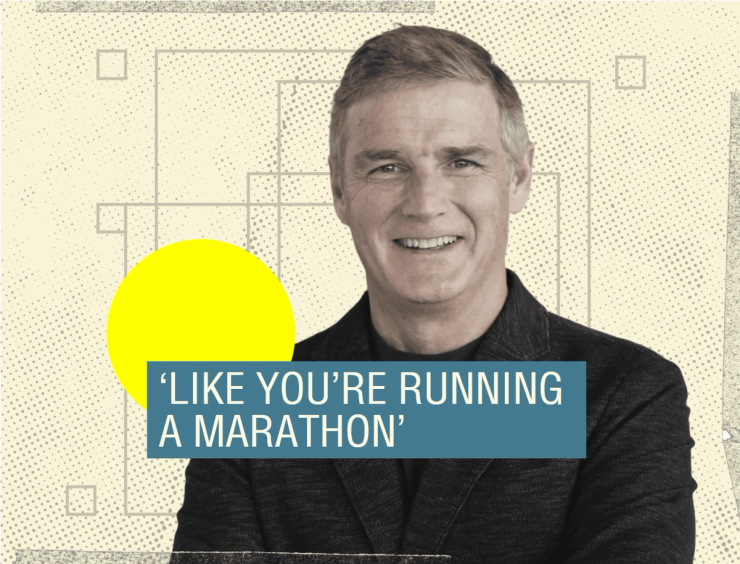The Signal Interview
Sports metaphors pepper Joe Preston’s conversation as he explains what it has taken to turn New Balance Athletics from an also-ran maker of much-mocked “dad shoes” into a brand taken seriously by Gen Z sneaker enthusiasts. The company’s AI efforts are “in the early innings,” he says, but he’s busy trying to get everyone to “run the play” his top team has agreed on, even though “it’s a complicated offense.”
“They’re relevant, and they’re frequent,” he says of the figures of speech. Preston — a keen golfer who says it would be a mistake to describe himself as a runner, given the sidewalk-pounding colleagues he works with — has been telling employees about the Boston-based group’s need for greater speed and agility since he was appointed CEO seven years ago, more than two decades after he began working for it.
New Balance is still owned by the family of Jim Davis, who bought it in 1972 when it was a six-person outfit making just 30 pairs of running shoes a day. As a private company, it releases few financial details, but Preston has overseen a sharp increase in its revenue, which has shot from a pandemic-dented $3.3 billion in 2020 to an expected $9 billion or more this year.
Adidas’ annual revenue is roughly three times larger, Nike’s revenue is about five times greater even after its recent struggles, and newer brands like Hoka and On are reshaping the competitive landscape, but New Balance’s reputation has been similarly transformed. The sneakers once derided by Ryan Gosling’s character in the 2011 film Crazy, Stupid Love as a brand that nobody other than a geeky Steve Jobs had any right to wear are now selling best among style-conscious 18- to 27-year-olds.
The sprints within a marathon
What set the brand on the path to five successive years of double-digit growth was New Balance’s decision in 2019 that its target market — or “our primary muse,” as Preston puts it — should be “the global independent.” Finding that singular focus on younger, more worldly, more individualistic consumers for its product development, its marketing campaigns, and its store designs was “a seminal moment,” he says.
But New Balance was soon hit by the store-closing chaos of the 2020 pandemic, and faced further upheavals as e-commerce and direct-to-consumer retailing changed how its industry operated. Turning a muse into a money-spinner has taken a rethink of New Balance’s approach to addressing disruption and pursuing new markets.
“We had this mantra called ‘Control our Destiny’ that we still have five years later,” Preston recalls. To keep pace with the cascading disruptions, New Balance in March 2020 came up with the idea of “sprints,” small teams working on defined projects that would help it “run the business and change the business at the same time.”
When it needed to push faster into digital commerce or build the technology to enable a successful direct-to-consumer business, for example, it assembled a dedicated team to address the challenge. “They work on these sprints that can vary from 30 to 90 days. And each team has the autonomy, authority, and accountability to come up with an action plan against that effort,” he explains.
Today, it has 16 such teams, “and we know that they’re changing our business,” but each has a finish line in sight: this group of sprinters will complete their projects at the end of November, before a new set of sprints begin in January.
“It’s like you’re running a marathon,” Preston says. “There are usually times in there where you’re sprinting and times where you’re trying to conserve your energy for the next sprint.” Building in time for recovery, and to plan the next burst of speed, is an important part of making the sprints effective.
Unlike lonely long-distance runners, though, Preston’s sprinters are guided by a centralized strategy team, composed of people from different corners of the business, which decides which initiatives to prioritize and oversees the teams’ progress. Preston gets updates on the sprints every Tuesday at a 7:30 am meeting. It was a “silver lining” of the pandemic, he says, which made the company create a weekly call employees could dial into from around the world, to make sure the brand was “driv[ing] a single message globally.”
Sprint team members return to the pack in due course, but Preston thinks that this way of giving many people exposure to the fastest-moving, most forward-thinking part of its business has been a way to change the pace at which the whole company operates. “Great organizations have been built when a function raises its level,” he says. “That sets a new bar. From that, you can see other functions raising [their game] as well.”
How athlete sponsorships build ‘brand heat’
The New Balance 990, released in 1982, was the first running shoe to cost as much as $100, but the company ceded its premium positioning as it broadened its market over the decades that followed. Another key decision Preston took in 2019 was that it would become “the best premium brand in the industry.”
There were doubts about its ability to do so, he admits, because the average selling price of its shoes in the US was about $58 while Nike’s average price tag was around $80. Today, he says, New Balance has inched ahead of Nike to about $83.
“You need to have brand heat to allow yourself to go upmarket,” Preston says. Partnerships with some of the world’s most followed athletes have helped: New Balance now has more than 400 sponsorship deals with sports stars from Olympic sprinter Gabby Thomas to NFL quarterback Josh Allen. On the shelves of Preston’s office are a New Yorker cover showing the Los Angeles Dodgers’ Shohei Ohtani, whose World Series win “definitely helped” sales, and a Wheaties cereal box featuring and signed by tennis champion Coco Gauff.
Preston has learned that brands need to “measure twice and cut once” when striking such deals to make sure that influencers’ values align with their own, and that New Balance can “tell their story within ours.”
He has also learned that the younger consumers it is targeting are “absorbing information in real time.” Live sports may be the last appointment viewing TV left through which brands can reach large audiences, and they need to be ready to capitalize on its most dramatic moments, he says. So when Gauff won the French Open in June, “we were ready at that moment” to activate a long-planned marketing campaign.
Quantifying the case for US manufacturing
Less glamorous elements of Preston’s strategy have been equally important to his repositioning New Balance. Controlling its distribution to ensure that it was showing up as a premium brand in full-price retail outlets — and avoiding discount stores — has been “a key part of its offense,” he says.
Its $1.2 billion apparel business could find faster growth than the 20% increase he expects for this year, for example, “but it would come primarily at that lower end of the market, which we don’t want to do.” Preston has shifted distribution from a triangle shape, with a small sliver of premium sales at the top and a broad base of cheaper sales, to a diamond, with more merchandise targeting the “upper premium” market and less reliance on low-end retail.
It is a playbook that other companies, such as Ralph Lauren, have used. But now Preston is leaning into a feature of the New Balance brand that none of his direct rivals can match: His company is the only major athletic shoe manufacturer that has maintained factories in the US.
Next week, New Balance will release a “Made in USA” study of its economic and social impact on its home market. The company has invested $155 million since 2021 in factories from Methuen, Massachusetts, to Skowhegan, Maine that sustain 1,200 manufacturing jobs. And, by its estimations, it has contributed $3.1 billion to US GDP.
US manufacturing remains “a small percentage” of the total, Preston admits, without disclosing details. But it is a point of differentiation that builds some “brand affinity” with consumers, gives employees a sense of pride, and educates policymakers about the importance of domestic manufacturing, he says.
Tariffs imposed on imports by the Trump administration this year have increased New Balance’s cost of goods by 3% to 4%, Preston says, but onshoring is “not for the faint of heart.” The economics and supplier ecosystem for US manufacturing are still challenging when compared to countries like Vietnam and Indonesia, which account for much of the brand’s production.
New Balance’s US factories focus on high-quality, premium-priced products, such as its heritage running styles, and Preston, a former head of the group’s Asia-Pacific business, sees another benefit: doing its own manufacturing in the US makes it a better partner to contract manufacturers overseas.
The costs of tariffs and uncertainty about the labor market in large Western economies are among the headwinds facing consumer goods groups as they approach the critical holiday season. But Preston is confident that New Balance’s workouts will pay off.
“The brand is in position, and we are performing really well within our wholesale partners,” he says. “You’re seeing a whipsaw effect in traffic trends, but [consumers] are coming out for the big moments. And I believe they’ll come out for the holiday.”
Notable
- A year into his role as Nike’s CEO, Elliott Hill is reshaping its team, fixing its culture, and looking to “make epic shit,” Fast Company reports. Products in the pipeline include exoskeleton sneakers, a jacket that inflates to keep the wearer warm, and “mind-altering footwear.”
- Nike and Adidas have lost ground to challenger brands like Hoka and On, in part after making “a mess of their distribution,” The Economist notes. But they remain the only sportswear groups to build successful fashion labels off the back of their running shoes.


